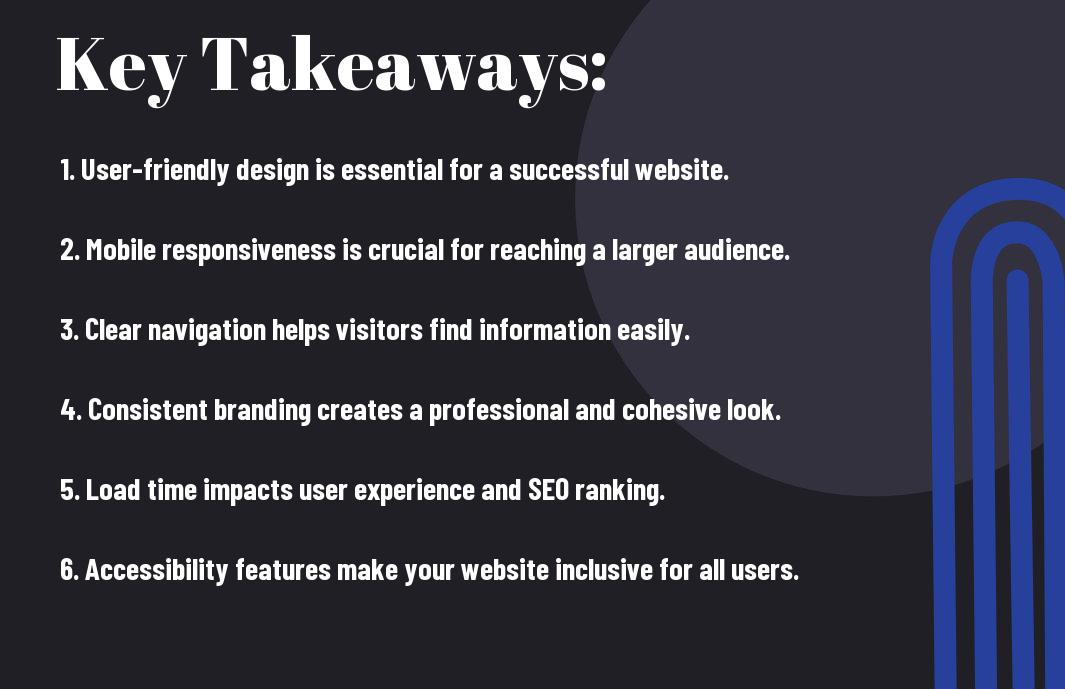Welcome to our comprehensive guide on the essentials of website design. Whether you are a business owner, aspiring web developer, or simply interested in creating your own website, understanding the fundamental principles of design is crucial for a successful and user-friendly online presence. In this post, you will learn about the importance of a responsive and visually appealing layout, the dangers of neglecting user experience, and the positive impact of incorporating intuitive navigation and clear call-to-action buttons. By the end of this guide, you will have a strong foundation to start designing your own website or effectively communicate with a professional designer.
Key Takeaways:
- User Experience (UX) is Key: Prioritize the user experience by creating a clear navigation, intuitive design, and fast load times.
- Mobile Responsiveness is a Must: With the increasing use of mobile devices, it’s essential to ensure your website is responsive and optimized for all screen sizes.
- Content is King: High-quality content that is relevant, valuable, and engaging is crucial for driving traffic and retaining visitors on your website.
- SEO Matters: Incorporating SEO best practices into your website design can help improve your search engine rankings and attract more organic traffic.
- Consistency is Key: Keep your design elements, branding, and messaging consistent across all pages of your website to maintain a cohesive and professional look.

Foundation of Good Design
Now, when designing a website, it’s crucial to lay a strong foundation for good design. Building a website without a solid foundation is like constructing a house on sand – it won’t stand for long. To understand the basics of web design, you need to pay attention to the essential elements that form the foundation. To get a detailed understanding, you can read this guide on What Are The Basics Of Web Design? | Excellent Guide 2023.
Understanding User Experience (UX)
When it comes to good website design, user experience (UX) is one of the most crucial factors to consider. UX design prioritizes creating a seamless and enjoyable experience for your website visitors. This includes easy navigation, clear information architecture, and intuitive design elements that guide users to the desired actions. By focusing on UX, you can ensure that your website is user-friendly and encourages visitors to engage with your content.
Principles of Visual Design
Visual design principles are the fundamental guidelines that govern how elements are arranged on a website to create a visually appealing and effective user interface. This includes aspects such as balance, contrast, emphasis, and rhythm. By applying these principles to your website design, you can create a cohesive and aesthetically pleasing layout that captures the user’s attention and guides them through the content effectively.
Building Your Website
After you have gathered all the necessary information and resources, it’s time to start building your website. This stage involves several key steps to ensure the successful creation and launch of your site. You will need to focus on choosing a domain and host, as well as designing the structure and layout of your website.
Choosing a Domain and Host
When choosing a domain name for your website, it is important to select a name that is relevant to your brand and easy for your audience to remember. Make sure the domain name is not too long and is easy to spell. Additionally, selecting a reputable web hosting service is crucial to ensure your website is accessible and secure. Consider factors such as storage, bandwidth, uptime, and customer support when choosing a hosting provider. It is essential to invest in a reliable hosting plan to avoid potential issues down the line.
Website Structure and Layout
Creating a clear and intuitive website structure is essential for providing a positive user experience. Organize your content into logical categories and subcategories, making it easy for visitors to navigate your site and find the information they are looking for. Choose a layout that is visually appealing and responsive across different devices. This will ensure that your website looks professional and functions seamlessly, regardless of how it is accessed. Remember to keep the design simple and consistent throughout your site to maintain a cohesive and professional appearance.
Customizing Your Website
Your website is your virtual home on the internet, and just like with a physical home, you want to make it reflect your personality and style. Customizing your website allows you to create a unique online presence that stands out from the competition. It also gives you the opportunity to tailor the user experience to meet the specific needs and preferences of your target audience. If you’re unsure where to start, here are some tips to help you get started. For more information on the basics of web design, check out this web design basics guide that will help you create a fantastic website.
Color Schemes and Typography
When it comes to customizing your website, choosing the right color scheme and typography is crucial. The colors and fonts you select can have a significant impact on the overall look and feel of your site. Color psychology plays a key role in influencing how visitors perceive your brand, products, and services. Additionally, your choice of typography can affect readability and user engagement. It’s important to consider how these elements can contribute to the overall user experience on your website.
Incorporating Multimedia and Interactive Features
Integrating multimedia elements, such as images, videos, and animations, can help bring your website to life. These visual and interactive features can enhance engagement and make your content more compelling. Whether it’s showcasing your products in action, sharing customer testimonials, or creating interactive experiences, incorporating multimedia can help convey your brand message in a more impactful way. It’s essential to strike a balance and ensure these elements complement your overall design and serve a purpose in enhancing user experience.
Optimization and Maintenance
Keep your website running at its best by focusing on optimization and maintenance. These are crucial aspects of website design that will ensure your site is not only visually appealing, but also functional and efficient.
Search Engine Optimization (SEO) Basics
When it comes to SEO, you need to consider various factors to ensure your website ranks well in search engine results. This includes using relevant keywords, creating high-quality content, optimizing meta tags, and acquiring backlinks from reputable sources. By focusing on these key elements, you can improve your website’s visibility and drive organic traffic to your site.
Ongoing Website Maintenance and Updates
Regular maintenance and updates are essential for keeping your website secure and performing optimally. This involves monitoring for any security vulnerabilities, updating plugins and themes, backing up your website regularly, and addressing any issues that may arise. By staying on top of maintenance and updates, you can ensure that your website remains in top condition and continues to provide a positive experience for your visitors.

Conclusion: The Basics of Website Design – What You Need to Know
Hence, it is important to understand the key elements of website design in order to create a successful and user-friendly website. By focusing on factors such as layout, color scheme, navigation, and content, you can ensure that your website is visually appealing and easy to use. Additionally, it is essential to prioritize mobile responsiveness and search engine optimization to reach a wider audience. By implementing these basic principles of website design, you can create a website that effectively showcases your brand, products, or services and provides a positive experience for your visitors. Ultimately, mastering the fundamentals of website design will enable you to establish a strong online presence and achieve your goals.
FAQ
Q: What is website design?
A: Website design is the process of planning and creating a website’s layout, visuals, and functionality. It involves elements such as color scheme, user experience, and overall aesthetic appeal.
Q: Why is website design important?
A: Website design is crucial because it directly impacts how visitors perceive a brand or business. A well-designed website can improve user engagement, conversion rates, and overall online presence.
Q: What are the key elements of website design?
A: The key elements of website design include layout, color palette, typography, imagery, and navigation. These elements work together to create a cohesive and visually appealing website.
Q: What are the best practices for website design?
A: Best practices for website design include responsive and mobile-friendly design, intuitive navigation, fast loading times, and clear calls to action. Accessibility and usability should also be prioritized for a positive user experience.
Q: How can I improve my website design skills?
A: To improve website design skills, consider learning web design principles, studying successful website designs, and practicing with design tools such as Adobe XD or Sketch. Keeping up with design trends and seeking feedback from peers can also be beneficial.
